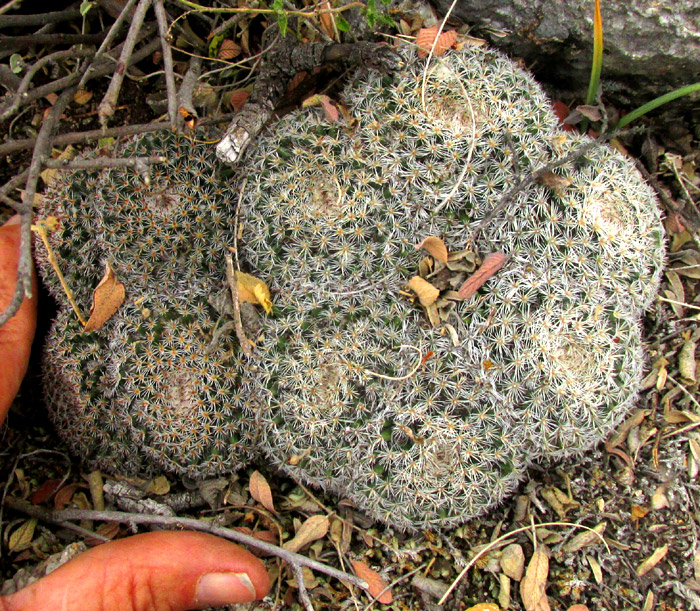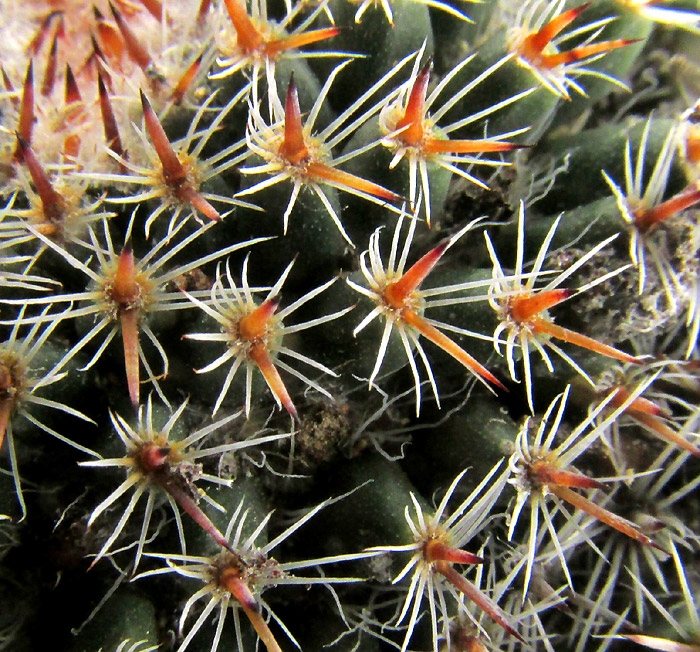Excerpts from Jim Conrad's
Naturalist Newsletter
Entry dated March 8, 2024, from notes taken on hill about 2kms west of Higuerillas, Municipality of Cadereyta de Montes; N20.9093°, W99.7859°, elevation ~1740 meters (~5700 feet); local narrow belt of vegetation constituting an extreme southern extension of the Chihuahuan Desert, Meridional Subregion; central Querétaro state, MÉXICO
OWL EYE CACTUS

In loose, crumbly, very dry soil at the base of a cliff of greywacke sandstone, the above unusually small, clustering cactus with more or less spherical heads displayed an interesting growth pattern. Later I'd read that the pattern seen above results from the original stem splitting in two, each split forming a new globose head. This splitting process can produce fairly large clusters of globose heads.

Several other key identification features were seen closer up. Spine clusters arose from atop relatively slender mounds, or tubercles. No shallow splits, or furrows, were visible on the face of each tubercle. All spines were straight, not hooked, and the tubercles were more or less rounded on top, indicating that here was yet another member of the genus, Mammillaria. In the Cactus Family, the Cactaceae, the mammillaria cacti constitute the largest of all cactus genera. Currently Kew's Plants of the World database recognizes 140 Mammillaria species.
Part II of the book Mapping the Cacti of Mexico, by Héctor M. Hernández and Carlos Gómez-Hinostrosa, tells us that 98.7% of all Mammillaria species occur in Mexico, with 88.2% being found only in Mexico. Further, "Six major areas of high species richness exist in Mexico: one is located in the Sonoran Desert (Baja California Sur), four in the Chihuahuan Desert (Jaumave, Guadalcázar, San Luis Potosí and Meridional subregion), and another one in the Tehuacán-Cuicatlán Valley." Here we're in one of those diversity hotspots, the Meridional subregion of the Chihuahuan Desert. With so many species, they can be hard to distinguish from one another, especially when dealing with individuals lacking flowers and fruits.

Above, key field marks distinguishing this mammillaria from others is that atop each tubercle around 16 relatively short, white radial spines radiate outward from the spine cluster center. In the center, two shorter, thick-based central spines bear tips which are blackish-raspberry but fade to pale orange at the spines' bases. In some mammillaria species, no central spines develop, as seen near the bottom of our Ladyfinger Cactus page. Other species, such as seen at the bottom of our Gaumer's Mammillaria page, produce only one central spine, and other species variously produce more than two central spines. Another distinctive feature is that white, weak bristles or trichomes sparsely arise between the bases of the tubercles.
All the above features point to a species often referred to -- along with several similar species -- as the Owl Eye Cactus, MAMMILLARIA PERBELLA.
Mammillaria perbella is endemic just to a narrow band of distribution stretching from central Mexico's San Luis Potosí state south into Oaxaca state. The species bears an English name because it's sold commercially as a potted plant. There's even a mutant form looking like a white, prickly worm wildly entangled with itself, the form 'cristata.'
The IUCN Red List categorizes Mammillaria perbella as vulnerable to extinction "... due to a limited geographic range (extent of occurrence approximately 3,000km2, known from 10 locations) and an ongoing population decline due to rural development, road construction and grazing (trampling)." I'm surprised they don't mention overcollecting, because in all of this area cacti are heavily collected for commercial sale both for local use and to intermediaries who traffic in them.